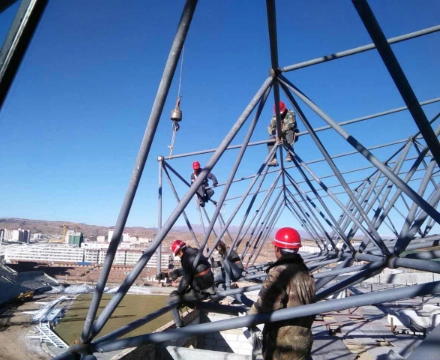Dapeng Town Industrial Park, Tongshan District, Xuzhou City, Jiangsu Province, China
With the increasing environmental pressures, traditional concrete construction is gradually being replaced by prefabricated buildings, creating a fast lane for the steel structure industry’s development.

The Ministry of Industry and Information Technology once issued the “13th Five-Year Plan for the Steel Industry – Adjustment and Upgrading Plan for the Steel Industry (2016-2020)” (hereinafter referred to as the “Plan”). The Plan emphasized keywords such as “reducing overcapacity, innovation, green construction, transformation, structural adjustment,” and more. The Plan set a directional goal for the proportion of steel used in steel structures, aiming to increase it from the current 10% in building construction to over 25%. It requires the accelerated promotion and application of steel structures, striving to increase the steel used in steel structures from the current 50 million tons to over 100 million tons.
Currently, steel structures in China are mainly used in industrial plants and infrastructure. As urbanization and industrialization continue until 2020, the demand in these two main sectors is expected to grow. While residential steel structures in China have constraints related to steel and cement prices, consumer habits, and architectural design systems, there is a trend towards improvement and progression. Due to China’s rapid steel industry development and the growing importance of energy-efficient construction, the policy direction of building technology has gradually shifted from restricting steel structure use in the past to promoting and developing steel structure applications, with positive support from national industrial policies.
Steel structures resolve the overcapacity issues in the steel industry
From the central to local levels, a series of policies promoting the rapid development of prefabricated and steel structure construction have been successively introduced. These policies have been accompanied by increasing support, signifying a “spring” in the development of steel structures within the construction industry. Incomplete statistics show that several provinces have implemented policies to boost the steel structure sector.
During the “13th Five-Year Plan,” Anhui Province strives to achieve a proportion of over 20% for the use of steel structure construction in new public buildings. The percentage of steel structure usage in urban and rural housing construction continues to increase. As a major steel-producing province, Shanxi is actively accelerating industrial transformation and upgrading, pushing for reduced overcapacity in the steel industry. Recently, the Shanxi Provincial Department of Housing and Urban-Rural Development also released the “13th Five-Year Plan for Housing and Urban-Rural Construction in Shanxi Province.” It aims to enhance energy efficiency in construction, with prefabricated construction accounting for 15% of new construction and green construction promoted at a rate of 50%, along with a 40% promotion of green building materials, in line with national planning levels.
Although the development of steel structure residences is relatively fast, changing past production and living habits is not an easy task. Currently, the proportion of true steel structure residences in China is very small, accounting for less than 1% of the entire construction industry. In contrast, developed countries like Europe, the United States, and Japan have steel structure housing percentages ranging from 20% to 50%, and steel structure bridge proportions ranging from 30% to 40%.
However, this significant market gap also reserves a substantial growth space for steel structure enterprises. For every 100 million square meters of steel structure construction added in China, it is estimated to drive a steel consumption of about 7 million tons. According to data from the National Bureau of Statistics, since 2012, each year, the total completed area of various types of buildings in China has exceeded 3.5 billion square meters. If 20% of the building area each year uses steel structures (i.e., increasing the proportion of steel structure buildings by 14 percentage points), it conservatively estimates an increase in steel demand of nearly 34 million tons. This effectively supports the reduction of steel and iron inventory, promoting the steel industry’s capacity reduction from the demand side.
Ultimately, the reduction of steel and iron production capacity will depend on the market. Investigations have shown that reducing the pressure of steel and iron inventory through increased demand is consistent with the essence of capacity reduction.
Exploring new models, breaking industry barriers
In recent years, green construction has indeed experienced a “surge” in policies and demand. According to forecasts from the Forward Industry Research Institute, with the promotion of China’s urbanization process, the market demand for steel structures will further expand. Steel structure buildings boast the advantage of a steel recycling rate of up to 90%. Once mass construction is achieved, steel structure buildings will become “steel storage warehouses.” As a representative of new building industrialization, steel structures have made significant progress as green buildings. However, the technical level and development of steel structures in China still have room for growth compared to other major countries worldwide. Although China has become the world’s largest producer of steel structures, related statistics show that the steel used in steel structures accounts for only 5%-6% of China’s steel production.